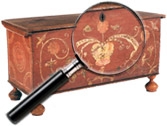|
|
Sutherland Tables
The Sutherland table is supposed to be named for Harriet, Duchess of Sutherland (1806 to 1868). It is a folding table whose top is so narrow that, when folded, it can be stood against a wall without taking up much space. When the leaves are swung up to sit on their gate-legs, it becomes large enough to be a small breakfast table. The earliest versions were commonly solid mahogany, later ones sometimes [...] Click here to continue reading.
Huntboards
Huntboard appears to be a twentieth century term for what Southerners referred to in their inventories as slabs or sideboards. They typically have taller legs than sideboards and contain fewer drawers or cabinets.
There is a myth that these serving pieces were often carried outside to provide refreshments for men just back from a hunt, but scholars now believe most slabs stayed inside the house.
—Information from Sarah Campbell writing in AntiqueWeek.
Tunbridge Wares
The wood parquetry or marquetry decorated wares bearing this name derive from the small town of Tunbridge Wells in the English shire of Kent where the process was first developed in the late seventeenth century.
A decoration of veneer found on small boxes, gameboards, picture frames and trays, the Tunbridge decoration was created when small sticks or strips of differently colored natural wood of six or so inches long were glued together [...] Click here to continue reading.
Slag Glass
Slag glass is defined as colored, opaque glass wih an altenate color swirled throughout giving the appearance of marbling. For this reason it is sometimes called marble or malachite or mosaic glass. Popular colors include butterscotch, green and purple. The name has been used by glass-makers only in recent times and is derived from the belief that the colors were acheived by adding “slag” from iron smelting works to the glass.
[...] Click here to continue reading.
Wooton Patent Desks
The Wooton Desk Manufacturing Co. was established in Indianapolis, Indiana in 1870 by William S. Wooton, a former minister turned furniture maker, and remained active until 1893.
The company is known for a group of elaborate walnut folding desks, first patented in 1874, in the Victorian Eastlake style which were essentially self-contained offices. These elaborate cabinets came in four grades: “Ordinary,” “Standard”, “Extra”, and “Superior”. The desks were expensive, prestige furniture, [...] Click here to continue reading.
Crazy for Tea
We’ve all seen the movies depicting English life in the 19th and early 20th centuries where a charming hostess calls on Flora, the parlor maid, to lay the tea for company. Flora soon reappears with a gleaming tea service and a plate of crumbly biscuits and sandwiches, and then retreats leaving the guests sipping and chatting. This English, and later the American, infatuation with tea may be easier to understand with [...] Click here to continue reading.
The Ephrata Cloister or Ephrata Community
The Ephrata Cloister or Community was a religious community established in 1732 by Johann Conrad Beissel at Ephrata, in what is now Lancaster County, Pennsylvania.
The community was descended from the pietistic Schwarzenau Brethren movement of Alexander Mack of Schwarzenau in Germany. The first schism from the general body occurred in 1728 – the Seventh Day Dunkers, whose distinctive principle was that the seventh day was the [...] Click here to continue reading.
.style1 { margin: 4px; }
The Foster-Lemmens Collection
THREE GENERATIONS OF ANTIQUARIANS
Foster’s Antiques of Wexford, Pennsylvania, like so many American businesses, had a small grass roots beginning. Bud Foster returned from World War II and started the business with his wife Tommie in 1946 on Route 910 in Allegheny County. The timing could not have been more perfect. GFs were returning home, and with the help of government financing, were [...] Click here to continue reading.
Estate of Joseph Stanley
For more than 200 years, residents and visitors passing in and out of New Hope, PA along Old York Road have scene a handsome high-walled mansion on the hill. Built between 1816 and 1823, Cintra was the dream of William Maris, a romantic and financially reckless entrepreneur who modeled his grand residence on a Portuguese castle of the same name.
For twenty-three years, the interior of the New [...] Click here to continue reading.
Francois Linke, Master Cabinetmaker of the Belle Epoque Era
After the fall and exile of Emperor Napoleon III in 1875, there continued to be a fine appreciation of the decorative arts of 18th century France. Into this period the twenty year old Francois Linke (1855 to 1946) literally walked, having trudged on foot from Budapest to Paris for greater opportunities. After such an inauspicious beginning, Linke became arguably the greatest exponent of the Louis [...] Click here to continue reading.
|
Recent Articles
- Charles Alfred Meurer – American Artist & Tromp L’Oeil Artist
- Sendak, Maurice – American Artist & Writer
- Godie, Lee – American Artist
- Davis, Vestie – American Artist
- Bartlett, Morton – American Artist
- Mackintosh, Dwight – American Artist
- Evans, Minnie Jones – African-American Artist
- Mumma, Ed (Mr. Eddy) – American Artist
- Nice, Don – American Artist
- Savitsky, John (Jack) – American Artist
- Gordon, Harold Theodore (Ted) – American Artist
- Dial, Thornton – African-American Artist
- Doyle Sam – American Artist
- Johnson, Lester Frederick – American Artist
- Finster, Howard – American Artist
|
|
